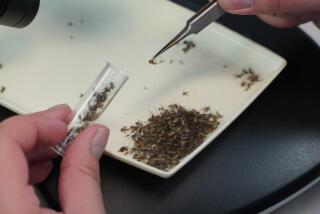Tuberculosis Cases Drop 14% in County During ’94 : Public health: No major outbreaks of the disease occurred. Statistics show increases in salmonella and chlamydia.
- Share via
SANTA ANA — Tuberculosis cases in Orange County dropped more than 14% last year, falling from an all-time high of 431 in 1993, when the disease struck 19 students at La Quinta High School alone, preliminary statistics show.
But the news was not all good in the disease tallies for 1994, soon to be published by the Orange County Health Care Agency. Cases of salmonella, a bacterial disease causing intestinal problems, jumped almost 45% to 647, prompting a warning from health officials to avoid eggs and poultry that are not thoroughly cooked. And chlamydia, a sexually transmitted disease, increased nearly 9% over 1993 in an upward trend that officials cannot entirely explain.
The TB drop after a precipitous four-year climb is encouraging, county tuberculosis controller Jody Meador said. The decline may result in part from aggressive efforts to trace the contacts of patients suffering from active TB and supervising the therapy of those who are afflicted, Meador said.
But “we certainly are not going to let down our intensive efforts” in response to a one-year dip, she said.
At least some of the decline is due to good fortune.
There were no outbreaks--clusters of cases often traced to single source--in the county last year. In 1993, more than 100 students at La Quinta High in Westminster tested positive for exposure to TB, and 19 were treated for the active disease. The U.S. Centers for Disease Control and Prevention concluded after an investigation that the outbreak began in part because a private physician did not properly treat and immediately report the case of a La Quinta student who had developed a drug-resistant strain of the disease.
Since then, Meador said, the county has redoubled its efforts to contact the close associates of anyone in the county who is infectious. Public health workers and nurses have been dispatched into communities to ensure that those infected take their medications for the required amount of time, Meador said.
The county has also sought to make physicians and the public more aware of tuberculosis and has pushed for prompt case reporting, said public health officer Hugh Stallworth. A law that took effect a year ago has helped by requiring health facilities to notify the county of treatment plans for TB patients before they can be discharged or transferred.
Sixty-two fewer TB cases were reported in 1994 than in 1993, but the caseload still has not dipped down to the mid-200s and low 300s reported before 1992.
“We must be cautious not to see any false security in that drop,” Stallworth said, explaining that a significant outbreak could send the numbers upward again. The county has given high priority to the TB control program, he said, and the program is not expected to be affected by the county’s bankruptcy.
*
Salmonella would appear to be a less pressing health threat than TB. Tuberculosis, mostly spread through coughing and sneezing, can be fatal if untreated. Salmonella generally causes stomach cramps, diarrhea and a fever for a week or less, and most people recover without antibiotic treatment.
But county health authorities say they are concerned to see such a dramatic leap in salmonella cases last year, because the illness is preventable and can be deadly to people with weak immune systems, including AIDS patients, babies and the elderly. Two elderly people in Orange County died last year of salmonella complications.
A rise in salmonella infections was first reported in the Northeastern United States a few years ago. Lately, however, increasing numbers have been reported in Southern California, including Los Angeles County. The state as a whole has seen only a modest increase in the last few years.
Half the cases reported in Orange County last year were caused by a strain known as salmonella enteritidis, which most often is acquired by eating contaminated eggs, county epidemiologist Hildy Meyers said.
To be safe, Meyers said, all eggs should be cooked until the yolk is hard, and all chicken cooked until the meat is no longer red. That means no soft-boiled eggs or French toast, Meyers said. Areas where poultry products are prepared should be thoroughly cleaned with soap and hot water.
“We’re not saying that every time you eat a raw egg you’ll get sick,” Meyers said. “We are saying there’s a risk there--even with cookie batter.”
Health officials are not sure what to make of a steady climb in chlamydia cases over the last five years. Testing methods for the sexually transmitted infection have improved, as has reporting by doctors, so the rise may not represent a true increase in disease, said Dr. Richard Thatcher, medical director for sexually transmitted diseases.
But infections caused by the microorganisms chlamydiae are most common among more sexually active people, generally younger people, and can signal an increase in unprotected sex in that population, Thatcher said.
“We can’t figure it out yet,” Thatcher said of the case increase in Orange County.
Around the country, other experts say, sexually transmitted diseases including chlamydia are flourishing among teen-agers and young adults. This population, in general, is less likely to use condoms and, once infected, less inclined to seek medical treatment.
*
Chlamydia is often without symptoms in women but can cause vaginal discharge and painful urination. Men can experience penal discharge and a burning sensation, although Thatcher said he has found that the infection shows no symptoms in 10% to 20% of his male patients.
The infection usually is treatable with antibiotics. Left untreated, however, it can lead to pelvic inflammation in women and sterility in men.
AIDS totals for 1994 are hard to interpret. Reporting variations and a change in the national AIDS definition two years ago make the numbers difficult to compare over time. The annual tally of cases appears, however, to be leveling off, officials said.
A breakdown of the 547 AIDS cases reported last year shows that African Americans, Latinos and women account for rising proportions of the caseload.
“We are behind the national trends . . . (but) it’s reflective of what’s going on in the” United States in general, said Penny Weismuller, disease control manager for the Health Care Agency.
In 1989, for example, 3% of the 291 cases were among African Americans; 16% among Latinos and more than 6% among females. Last year, 5% of the 547 cases were among African Americans, 26% were among Latinos and nearly 8% were among females.
Mixed News on Diease Tuberculosis cases in Orange County dipped 14% last year from an all- time high in 1993. Cases of salmonella, however, shot up nearly 45%. And Chlamyidia cases continued a five- year climb tha could be due in part to improved testing and reporting. Here are the trends: *
Chlamydia* ‘94: 4,563 *
Tuberculosis ‘94: 369 *
Slmonella ‘94: 637 Source: Orange County Health Care Agency; Researched by JULIE MARQUIS / Los Angeles Times
More to Read
Sign up for Essential California
The most important California stories and recommendations in your inbox every morning.
You may occasionally receive promotional content from the Los Angeles Times.













